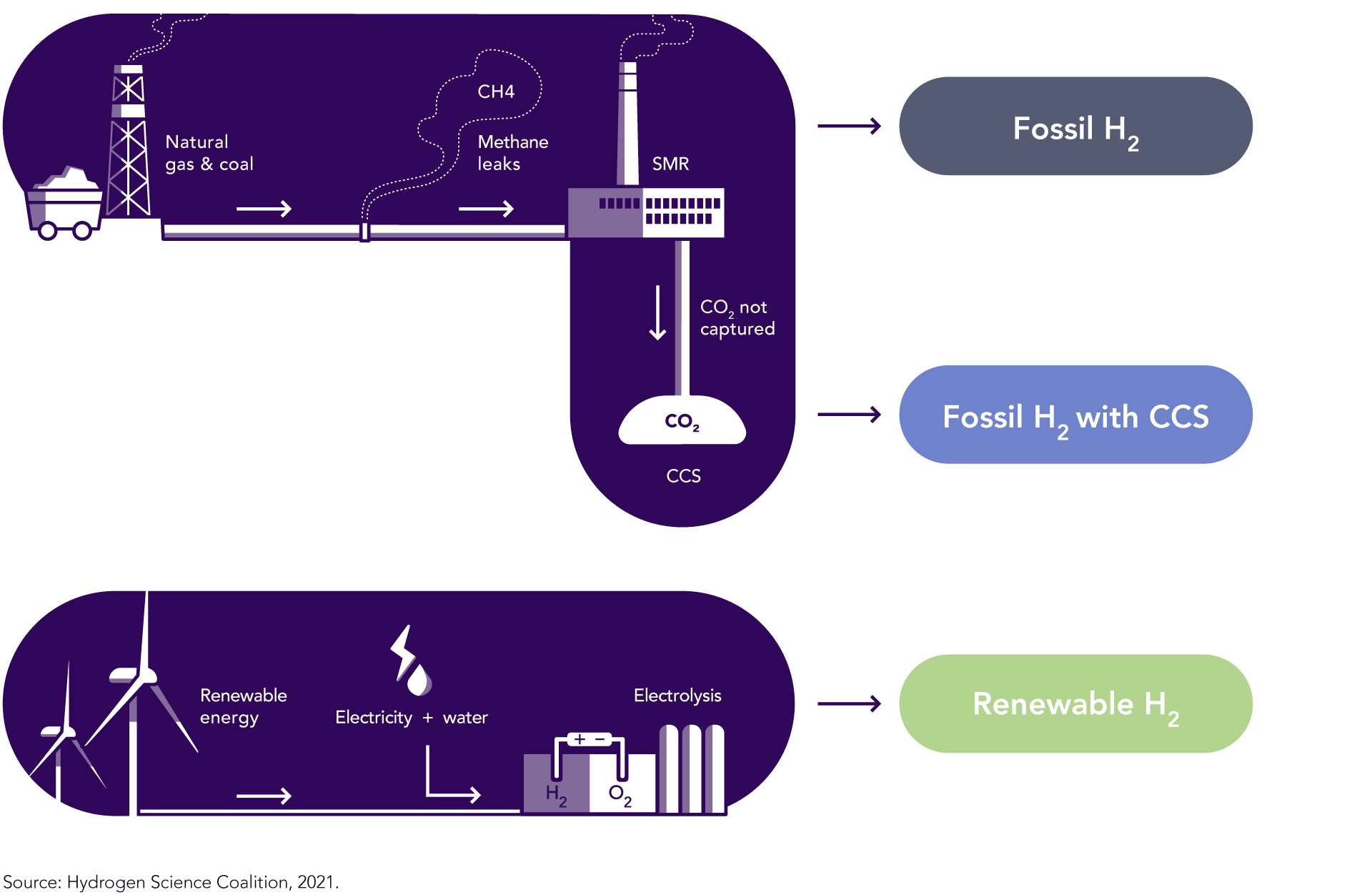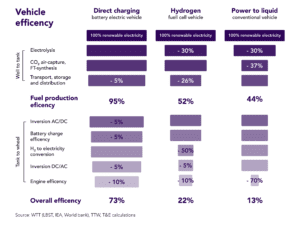Putting facts into perspective on hydrogen’s role in the energy transition
Using hydrogen for heat and power is not new, but its role in the energy transition is complex. We’ve distilled some of the key facts and reports on the role hydrogen can play in the energy transition to put things into perspective.
First things first, what exactly is hydrogen?
Hydrogen is a chemical element which rarely exists on its own on earth. It is not a primary source of energy, and must be produced using existing energy.
In essence, hydrogen is best thought of as an energy carrier, not dissimilar to a battery.
But given the huge amount of energy needed to produce, transport and store hydrogen it is a very inefficient energy carrier. It’s likely it will not be available for use at a large scale.
Hydrogen can be produced from different types of energy.

Fossil Fuels
Hydrogen can be produced from coal, oil or natural gas, by Steam Methane Reformation (SMR) with or without carbon capture and storage (CCS). It is highly an energy intensive process, meaning that fossil-based hydrogen without CCS is many times more polluting than just using coal, oil or natural gas outright.
Renewable electricity
Hydrogen can also be produced using electrical energy to split water molecules in a process known as electrolysis, creating only oxygen as a by-product. If the electrical energy is made from renewable sources – for example wind and solar energy – then the process is close to zero emissions and called renewable hydrogen. It is often also referred to as ‘green hydrogen’.
Nuclear electricity
It’s also possible to produce hydrogen from electricity made from nuclear energy.
Many governments and businesses are touting a clean hydrogen economy as the key to the energy transition.
The two forms of ‘clean’ hydrogen most commonly considered to decarbonise the energy system are renewable hydrogen and fossil hydrogen with CCS, also known as green and blue hydrogen.
But is hydrogen really a clean solution?
Emerging studies like this one show that the only scalable and truly low-emissions hydrogen is produced from solar or wind-generated electricity.
Other studies like this one depicted in the graph opposite, have cast doubt on the climate credibility of fossil hydrogen with CCS, finding that its greenhouse gas intensity can be up to 20% worse than burning natural gas for heat.
This is because fossil hydrogen with CCS is produced using a significant amount of natural gas, which amplifies the issue of methane leaks in the natural gas supply chain. Human-made methane emissions are up to 80 times more potent than CO2 at warming the climate over a 20 year timeframe.
CCS technology today also only captures some of the emissions, and will never capture 100%.
We can’t assume hydrogen made from fossil fuels and CCS will by default be low emissions. Relying on it as a climate solution is risky, as assessing and mitigating the lifecycle emissions of fossil hydrogen with CCS is a complex issue that could take many years.
Despite the excitement around renewable hydrogen and fossil hydrogen with CCS, large-scale ‘clean’ hydrogen projects are yet to be fully realised today.
So, what role should renewable hydrogen play in the energy transition?
We know that to reduce the impact of climate change, we need to act today. This means using all solutions that we already have. Electrification is already cheaper and more widely available than renewable hydrogen solutions which are still in their infancy.
We should deploy near zero emission renewable hydrogen to replace current polluting fossil hydrogen first, followed only by niche sectors that don’t have existing electrification solutions.
Today the world produces 120 million tonnes of hydrogen annually. 98.7% of this is made from fossil fuels – natural gas, coal or oil – without CCS.
It is mainly used in making ammonia fertiliser for food production, for chemicals such as methanol and to remove impurities during oil refining.
This fossil hydrogen, also known as grey hydrogen, emits around the same emissions as the global aviation industry every year.
To decarbonise the hydrogen we’re already using today, we need almost three times the amount of wind and solar electricity that the world produced in 2019.
Given how much energy we will need to only decarbonise where fossil hydrogen is already polluting today, we need to take a prioritised approach to where hydrogen is used.
Facts on hydrogen and domestic heating
Hydrogen is inefficient for heating
- Fossil hydrogen with CCS made from natural gas uses at least 40% more gas than boilers using natural gas outright, and so would increase the gas imports of many countries, undermining energy security.
- Powering boilers with renewable hydrogen uses x5.5 more renewable energy than the renewable energy used for heat pumps.

- Heating all the buildings in the UK with renewable hydrogen needs the UK’s existing offshore wind generating capacity to increase by a factor of 33. Using heat pumps would only require the existing offshore wind generating capacity to increase by a factor of around 6.5.

Heat pumps are cheaper for consumers
- BEUC, the European Consumer Organisation, found that electric heat pumps are the cheapest green heating option for consumers, and that hydrogen boilers will never be a cost effective solution. Heat pumps will also reduce consumers’ heating costs by up to 25% compared to nautral gas.
- Powering hydrogen boilers in the EU will be 50% more expensive for households in 2050 than using heat pumps.
- Installing a combustion hydrogen boiler will also cost 43% more than a heat pump in the UK by 2030, according to BloombergNEF.
Facts on hydrogen and transport
Electric vehicle solutions are more efficient
- It takes about 3.3 times more electricity to power a hydrogen fuel cell truck than one running on an Electric Road System.
- Battery vehicles are around 3.2 times more energy efficient than hydrogen fuel cell cars. The group below originally from Transport and Environment shows the energy losses.

Scaling hydrogen requires massive amounts of land
- To power all European air traffic with renewable hydrogen, Europe would need a land mass larger than the size of Hungary to operate 119,800 large wind turbines of 8.4 MW.
What about blending hydrogen into the existing natural gas grid?
Some governments and businesses are considering blending up to 20% hydrogen directly into the natural gas grid to help cut emissions.
In most European countries, blending hydrogen into the existing natural gas pipelines won’t be possible beyond 20% hydrogen, before needing infrastructure retrofits.

It’s easy to expect that blending 20% of renewable hydrogen into the natural gas grid would save 20% of greenhouse gas emissions.
However a 20% mixture of hydrogen with natural gas in a pipeline has only 86% of the energy efficiency of pure natural gas.
You’d have to burn 16% more of the blended mix to create the same heat energy. This means the savings in greenhouse gas emissions are nowhere near 20% — they’re closer to 7%.
A smooth transition between natural gas and hydrogen in our current natural gas pipeline infrastructure isn’t possible, as it requires a replacement of the existing natural gas infrastructure once blending limits are maximised.
Given how valuable (and inefficient) renewable hydrogen is, blending it into the existing gas grid does not make sense due to its limited impact on emissions savings. Other sectors, like fossil hydrogen today, need to be decarbonised first.
In summary
A successful climate action plan means deploying all the solutions we have within the right sectors which will make the most impact on cutting emissions. Hydrogen has a key role to play – but it will be limited to sectors that most need it.
For more briefings and commentary, check out our blog section. For more information on our position on hydrogen, check out our Principles.


